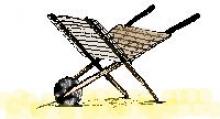Labour-saving technologies and practices: manual carrying, wheelbarrows, hand carts and bicycles
Human porterage (either on the head, shoulders or back) is common in many rural areas, particularly where access roads are in a poor condition. The following describes the features of carrying aids such as wheelbarrows, handcarts, bicycles, and trailers. Their advantages and disadvantages are also explained.
Description
1. Features of carrying aids for head, shoulders and back
1.1 Shoulder pole
- Loads such as fodder are suspended directly from a bamboo pole or placed in two baskets at either end of the pole.
- Alternatively one laden pole is carried between the shoulders of two people.
1.2 Back frame
- Simple frame made from woven grass and wood and similar to open rucksack.
2. Features of wheelbarrows and handcarts
2.1 Wheelbarrows
- Mainly used for transport of small loads (up to 100 kg) over short distances (up to 1 km).
- A reasonably large diameter wheel (over 30 cm) reduces rolling resistance compared to a smaller diameter.
- Sturdy axles and bush assemblies that are well-connected to the frame are important, as these components are a frequent cause of breakdowns.
2.2 Handcarts
- Mainly used for transport of larger loads (up to 200 kg) over longer distances (up to 10 km).
- Use two, three or four wheels to support the load.
- When using two-wheel carts, the cart design should ensure the centre of gravity of the load is nearly over the axle of the wheels to minimize the load on the arms.
- Large diameter wheels with ball bearings minimize rolling resistance (bicycle wheels are commonly used).
2.3 Handcarts for use with water pots or jerry cans
- They usually have a large diameter single wheel with ball bearings or two wheels fairly close together, so that they can be used on footpaths.
- Low slung cages hang on either side of the centre of the cart in which jerry cans or water pots are placed.
- They have a low centre of gravity for stability.
3. Features of bicycles and trailers
- Bicycles are a very important means of transport in rural Africa, both for personal transport and for the transport of light goods.
- The speed of travel is much higher than walking, and they can be used on fairly poor surfaces, such as access roads, tracks and footpaths.
- Carrier racks above the rear wheel are used for people and goods.
- Heavy loads can be transported (such as sacks of grain or bananas), in which case the bicycles are often pushed over the more difficult terrain.
- Bicycle taxis, such as the "Boda Bodas" in Uganda, play a very important role in transport in and around villages.
- Trailers are similar to two-wheeled handcarts and are towed behind the bicycle.
- They are usually made using bicycle wheels and are mainly suitable for fairly flat terrain.
4. Advantages
- Labour-saving
- Significant labour savings compared with carrying items unaided.
- Drudgery is reduced and allows carrying heavier and larger loads.
- Livelihood strengthening
- Transport bottlenecks are reduced and so delays are reduced.
- Livelihood resilience diversification
- Opportunities to earn income by providing rural transport to others.
- Energy and time required are less, so there is opportunity for other activities.
- Equipment
- Easy to fabricate, maintain and repair.
- Skills
- Low skill level required.
- Maintenance skills likely to be available in the community.
- Cost and risk
- Low investment and operating costs; hence minimal financial risks.
- Infrastructure
- Only slight improvement to road infrastructure required for their use.
5. Disadvantages
- Labour
- Limited impact on labour-saving, low carrying capacity and low speed compared to animal and motorized power sources.
- Infrastructure
- Paths need to be reasonably smooth and flat for the use of wide carts.
Figure 1. Wheelbarrow

©FAO/TECA
6. Agro-ecological zones
- Tropics, warm.
7. Related/associated technologies
- Labour-saving technologies and practices: pack animals and animal drawn carts: ID 7311.
- Draught animal power technologies in East Africa: ID 4535.
- Development of tools for draught animals: ID 4483.
- Labour-saving technologies and practices: draught animal power and implements: ID 7306.
- Improving the productivity of draught animal power in sub-Saharan Africa: ID 4467.
- Labour-saving technologies and practices: draught animal powered and motorised crop processing: ID 7307.
- Labour-saving technologies and practices: manual crop processing: ID 7317.
- Labour-saving technologies and practices: manual and motorised cleaning of grains and pulses: ID 7310.
8. Objectives fulfilled by the project
8.1 Labour saving technology (LST)
The practice reduces manpower needed for transportation compared to manual methods. However, the reduction is not significant since the carrying capacity is low.
8.2 Pro-poor technology
The practice improves productivity and offers opportunities to earn income by providing rural transport to others.
Author: Rural Infrastructure and Agro-industries Division (Agricultural Machinery and Infrastructure) AGS in FAO
Organization: The Food and Agriculture Organization of the United Nations FAO TECA
Year: 2020
Type: Practices
Full text available at: https://www.fao.org/teca/en/technologies/7312
Content language: English
